By Cecilia Ellis ’17
Registration opens in Baker University Center at 8:30 am, and West 82 quickly fills with dozens of girls donning their new lime-green shirts declaring their status as “Tech Savvy Girls,” excitedly chatting in anticipation of the day ahead.
It’s the second annual Tech Savvy event, Saturday May 30, 2015—a day for local Appalachian middle school girls to get hands-on experience with math and science. Organized by Dr. Sarah Wyatt, Professor of Environmental & Plant Biology, and Dr. Melanie Schori, a postdoctoral fellow, it could be just another fun field trip for some, but for others it’s inevitably the beginning of a life-long passion for science.
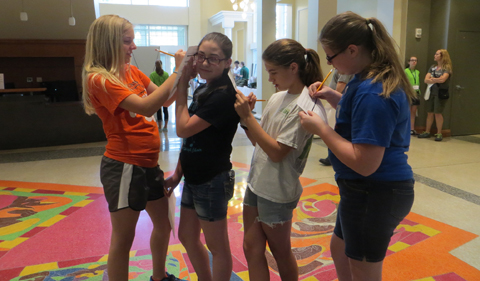
IMG_8259
Mckenzie Penrod, Kayleah Shiland, Soren Lawrie, Brooke Childers help each other fill out registration.
Three rounds of workshops were planned for the morning, with several different events happening at once so that all the girls could participate in three of the activities of their choosing. The workshops range from “Girls Who Code” for those interested in computer science to “Dance Pad Mania” where girls got to design their own electric circuit.
ContraDancing was one of the first round’s choices, described in the itinerary as “a morning of folk music, mathematics, and joyful dancing!” Similar to a math problem, the girls worked to figure out if the order in which they did certain dance moves mattered. They came to find that it does because of the unique outcome of mixing one move with another. ContraDancing incorporates the creative act of dance with the critical thinking skills of problem solving, and the result was fun.
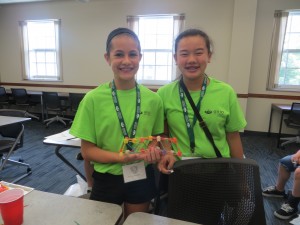
Lelila Kennedy (12) and Allison Baughman (12) after winning the bridge-building competition.
Across campus an engineering competition was held to see which group of girls could build a bridge capable of supporting the most weight. Their tools? Gum drops and tooth picks. Four groups of girls constructed their own bridge each, and ultimately the winning Team Baughman (made up of Lelila Kennedy and Allison Baughman, both age 12) won as their candy contraption held a cup full of 45 jolly ranchers—only one jolly rancher more than the bridge made by the Ohio engineering students leading the workshop!
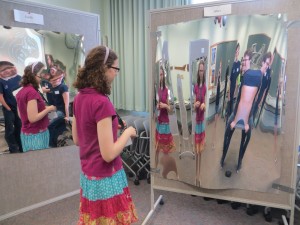
Abigail Tadlock exploring her appearance on Mars.
A gravity workshop, led by Wyatt, attempted to demonstrate to the girls how genes regulate gravity. During her lesson, she filled the classroom with fun-house mirrors to show each girl what she might look like on another planet, one with a different gravity exerting its force on her body. She also simulated Microgravity by dropping a full beverage can from the top of a ladder into a garbage can below in an experiment similar to what is done at Drop Towers. This free fall, the kind that is responsible for the lifting feeling in your stomach when you’re going down on a fast elevator, is an experience with microgravity.
“Decoding DNA” was a workshop that explained the process that occurs within our body changing DNA into RNA and further into protein. The girls who attended this lesson got some hands-on experience with the act of translating gene sequences by completing a bracelet that represented their new sentence of code for protein. Volunteer Josiah Pugh explained the activity as “giving them a sequence, and in the sequence is a hidden message, and then they create bracelets based on what that sentence says.” The girls get to walk away with new knowledge of their body and a souvenir they can wear proudly showing it off. It’s biology plus jewelry!
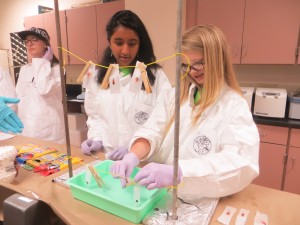
Shifra Narasimhan (12) and Sydni Roell (14) working with ink chromatography at the CSI Athens workshop.
The real hustle and bustle throughout the day occurred in the CSI Athens lab, the workshop that simulated a crime scene investigation. Dr. Rebecca Barlag and Dr. Lauren McMills, Ohio professors in Chemistry & Biochemistry, hosted six different stations of activities similar to lab technician work: crime scene photography, body measurement, foot printing, ink analysis chromatography, blood identification, finger print dusting.
McMills expressed her desire to have this workshop in a world of popular CSI TV shows. “[Forensic chemistry] is interesting, but they can forget about the science….It’s not all what they see on TV! It’s critical thinking and problem solving.”
The room was buzzing with groups of girls in their white lab coats excitedly theorizing about who done it. “He needs a better sense of style,” participant Bethany Flannery joked about the fake body.
Wyatt, one of the women responsible for putting on the event, said the event’s main goal is “to encourage girls to go to college and go into STEM fields.”
In the opening presentation, Schori—the president of the local chapter of the American Association of University Women—explains that STEM stands for science, technology, engineering, and math fields, the particular studies in which the number of women is sorely lacking. Schori displayed statistics on the number of women in STEM careers and explained how this was tied into our culture’s stigma on these areas of study as being inherently for males. “We’re here today to try and change that. We’re here to tell you that you can go into these fields and be successful.”
Tech Savvy is a national, annual event hosted by the AAUW with 12 workshops across the country this year that focus on ensuring that young girls are given every opportunity to get to college. This year’s event was the second of its kind at Ohio University, but they don’t plan on stopping anytime soon; The date for next year’s conference is Saturday, May 14, 2016.
Be sure to check out the Ohio Tech Savvy website for more information and like them on Facebook.


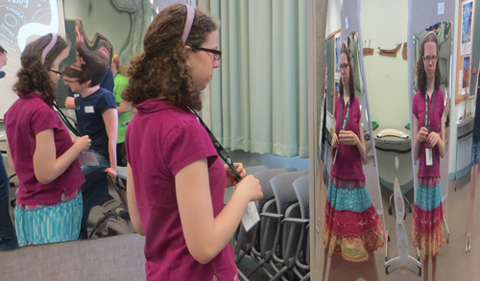


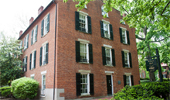














Comments